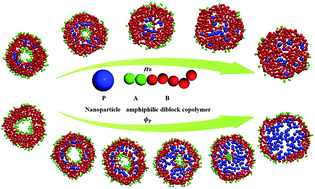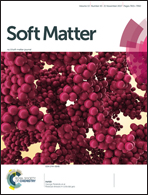Nanoparticle encapsulation in vesicles formed by amphiphilic diblock copolymers†
Abstract
We investigated the co-assembly of nanoparticles P and amphiphilic diblock copolymers AB in selective solvents using a dissipative particle dynamics (DPD) method. By controlling the nanoparticle concentration and the interaction parameter between the hydrophobic blocks and the solvents, we found that the aggregation morphology can be changed from rod-like micelles to disk-like micelles and further to vesicles. The ratio of the hydrophobic/hydrophilic block and the nanoparticle concentration largely affects the structural characteristics of vesicles and the dispersion of nanoparticles. Copolymers with a longer hydrophobic block length are more likely to form vesicles with a smaller aqueous cavity size and vesicle size as well as a thicker wall. At the same time, the nanoparticles in the hydrophobic membrane tend to locate closer to the center of the vesicle and they become more compactly organized. A significant discovery has found that the larger the nanoparticle concentration, the smaller the aqueous cavity and the larger the vesicle size. We can also locate the nanoparticles at the center of spherical micelles or the hydrophobic membranes of vesicles by varying the nanoparticle concentration. This provides an effective and simple method to prepare size-controlled vesicles containing nanoparticles, project the localization of nanoparticles within the vesicles, and even tune the distance between the nanoparticles.



 Please wait while we load your content...
Please wait while we load your content...